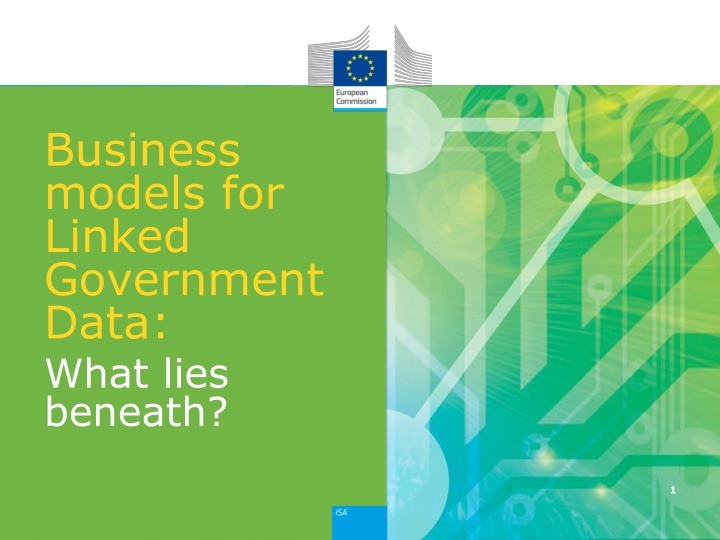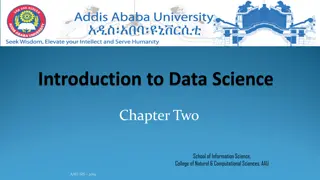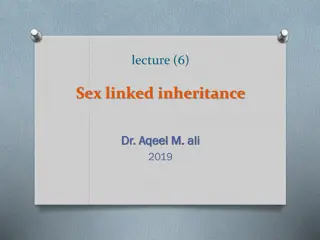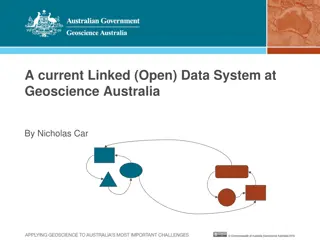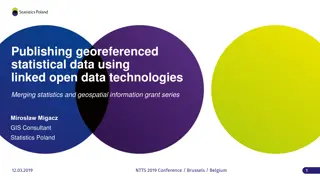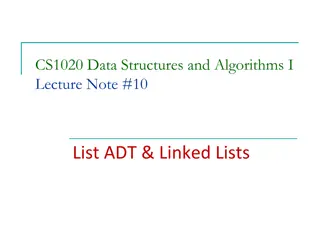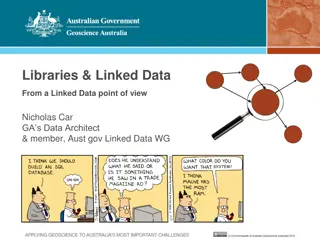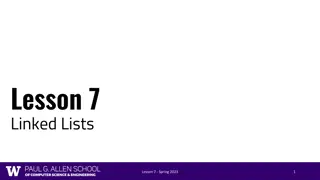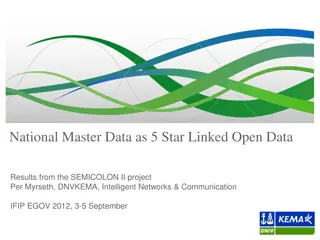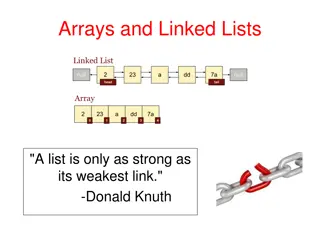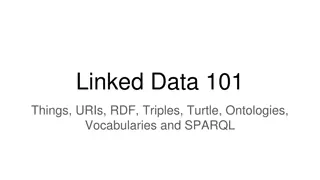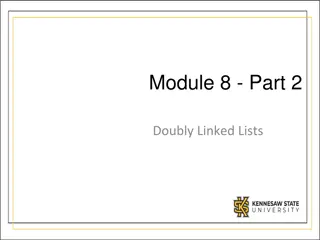Uncovering Business Models for Linked Government Data
Delve into the exploration of business models for linked government data through a comprehensive study under the European Commission's ISA Programme. Discover key stakeholders, methodologies like the Business Model Canvas, case studies, and the potential value of Linked Open Government Data. Uncover insights into the costs, enablers, and barriers in providing LOGD services, shedding light on the impact on businesses, citizens, and administrations.
Download Presentation

Please find below an Image/Link to download the presentation.
The content on the website is provided AS IS for your information and personal use only. It may not be sold, licensed, or shared on other websites without obtaining consent from the author.If you encounter any issues during the download, it is possible that the publisher has removed the file from their server.
You are allowed to download the files provided on this website for personal or commercial use, subject to the condition that they are used lawfully. All files are the property of their respective owners.
The content on the website is provided AS IS for your information and personal use only. It may not be sold, licensed, or shared on other websites without obtaining consent from the author.
E N D
Presentation Transcript
Business models for Linked Government Data: What lies beneath? 1
About this work A study delivered under Action 1.1 on Semantic Interoperability of the ISA Programme of the European Commission Delivered by o Phil Archer, W3C o Makx Dekkers o Stijn Goedertier & Nikolaos Loutas, PwC EU Services Download the full report from: o https://joinup.ec.eur opa.eu/node/72473 SEMIC SEMANTIC INTEROPERABILITY COMMUNITY 2
Outline 1. The business need The LOGD ecosystem 2. The methodology Detailed analysis of case studies using the Business Model Canvas TM 3. Our main findings administrations? What does it cost to provide LOGD services? Who pays for the provisioning of LOGD? What are enablers and barriers with regard to the value creation of LOGD? What value does LOGD bring to businesses, citizens, and public 3
The business need the LOGD ecosystem The key stakeholders: Data providers Data consumers Data brokers Regulatory entities 4 Li Ding, Vassilios Peristeras, Michael Hausenblas: Linked Open Government Data [Guest editors' introduction]. IEEE Intelligent Systems 27(3): 11-15 (2012) Roadmap of linked open government data from our editorial in IEEE IS [1]. http://ieeexplore.ieee.org/stamp/stamp.jsp?tp=&arnumber=6237454
The methodology the Business Model Canvas Customer Segments Key Partnershi ps Value Propositio ns Channels Key Activities Key Resources Cost Structure Revenue Systems 5 All credits to businessmodelgeneration.com
The methodology the case studies 32 AT: Renewable Energy and Energy Efficiency Partnership; DE: German National Library; EU: Europeana; EU: European Commission Directorate-General Health and Consumers; EU: European Environment Agency; EU: Publications Office of the European Union; IT: Agenzia per l'Italia Digitale; UK: BBC; UK: Companies House; UK: Department of Environment, Food and Rural Affairs; UK: National Archives; UK: OpenCorporates; UK: Ordnance Survey; Food and Agriculture Organization of the United Nations. Identified LOGD pilots 11 Cases selected & interviewed 6
Our findings value proposition integration and enables the interconnection of previously disparate government datasets. Increase in data quality: The increased (re)use of LOGD triggers a growing demand to improve data quality. Through crowd-sourcing and self-service mechanisms, errors are progressively corrected. New services: The availability of LOGD gives rise to new services offered by the public and/or private sector. Cost reduction: The reuse of LOGD in e-Government applications leads to considerable cost reductions. Flexible data integration: LOGD facilitates data 7
Our findings key resources persistence is not often made explicit. Many organisations cite a lack of tools that meet their specific need in their specific context. Skill and competencies are mostly acquired in-house with some help from external consultants. LOGD is applied most successfully in reference data. URI design policies are generally in place, while The European Environment Agency has a URI policy based on Cool URIs. 8
Our findings key partners & customer segments networks of government and non-government organisations. There is little use of LOGD outside of those networks or by businesses. Most providers apply LOGD in the context of existing peer The key partners of the UK National Archives are the UK Parliament and the Publications Office of the EU. The most prevalent use in the case of the UK National Archives is internal reuse. 9
Our findings key activities & customer relationships LOGD services as part of their normal system maintenance and operational activities. Only few invest in promotional activities, such as branding or advertisement of LOGD services. There is little user support. Feedback is typically through informal communications as part of institutional collaborations. Providers consider the development and maintenance of The German National Library is reaching out to reusers of its Linked Data via presentations, its web page, articles in journals, participation in book fairs, and library- and information-related fairs. 10
Our findings channels SPARQL endpoints. Bulk downloads are almost always offered. Proprietary apps and Web applications are less common. Distribution channels include direct URI resolution and The experimental SPARQL endpoint of Europeana is availabe at: http://europeana.ontotext.com/ The SPARQL endpoint of EU Open Data portal, managed by the Publications Office, is available at: https://open- data.europa.eu/en/linked-data 11
Our findings cost structure Many providers consider LOGD activities as part of their core business; No separate cost structure of the LOGD activities is available. In case figures in terms of finances or staff resources were mentioned in the case studies, these spanned a wide range depending on the approach taken. It took the UK companies House about 2 person-months to develop its Linked Data service, while the Linked Data infrastructure of the FAO costed approximately EUR 100k. 12
Our findings revenue streams of the normal budgets. The data is provided free of charge. Licences are either open or not explicitly defined. The predominant revenue model is public funding, as part Linked Data provided by the UK Companies House are available under the UK Open Government Licence. Linked Data provided by the BBC are available for non- commercial use only. 13
Conclusions LOGD enablers Efficiency gains in data integration the network effect. Forward-looking strategies. Increased linking and integrated services. Ease of model updates. Ease of navigation. Open licensing and free access. Enthusiasm from champions . Emerging best practice guidance. 14
Conclusions LOGD roadblocks Necessary investments. Lack of necessary competencies. Perceived lack of tools. Lack of service level guarantees. Missing, restrictive, or incompatible licences. Surfeit of standard vocabularies. The inertia of the status quo. 15
Conclusions LOGD outlook important in the provision and management of reference data. It is used to increase efficiency of internal data integration, or to support data exchange in existing collaborations. Providers will have to develop a clear view of their customers, as value lies in reuse. LOGD is becoming increasingly adopted, particularly 16
Your questions Thank you! 17
ISA Programme Action 1.1 Semantic Interoperability Project Officer Contractors Vassilios.Peristeras@ec.europa.eu Stijn.Goedertier@be.pwc.com Nikolaos.Loutas@be.pwc.com Visit our initiatives Get involved ADMS. SW DCAT application profile for data portals in Europe logo ADMS_logo.png CoreBusiness_logo.png http://www.deviantart.com/download/306854489/new_twitter_logo_by_ockre-d52oyft.png Follow @SEMICeu on Twitter SEMIC group on LinkedIn Join SEMIC group on LinkedIn CORE PUBLIC SERVICE core_location_logo.png CorePerson_logo.png core_vocabularies_logo.png https://joinup.ec.europa.eu/sites/default/files/ckeditor_files/images/SEMIC_Community_Logo.png Join SEMIC community on Joinup VOCABULARY 18
SEMIC 2014 Athens, 9 April http://semic.eu 19
